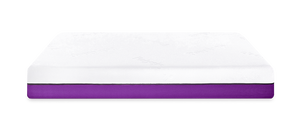What you will learn:
- The Risks of Working from Bed: Discover the potential pitfalls of using your bed as a workspace, from posture problems to productivity pitfalls.
- How to Set Up Your Bed for Work: Learn essential tips and tricks for creating a comfortable and ergonomic workspace in your bed, including mattress selection, laptop setup, posture support, and more.
- Tips for Maintaining Productivity and Wellness: Discover strategies for staying focused and healthy while working from bed, including switching positions, avoiding spills, and more.
One of the downsides of making some of the best mattresses in Canada is people want to stay in bed all the time, even when they shouldn’t.
When everyone was forced to work from home, many people chose the confines of their beds. As fun as this was for the first few months, we quickly realized it wasn’t sustainable. Soon, there were increasing reports of back pain, neck pain and even trouble sleeping.
While this led many to immediately write off working from bed, we were just doing it all wrong. This guide will teach you how to make working from your cozy mattress the dream escape it was meant to be.
But first, let’s look at what happens when you don’t get it right.
What happens when you work from bed?
So, you can have breakfast in bed and watch movies in bed, but you can’t work from bed? Why is that?

The first problem for most people is body pain from poor posture. At the height of COVID-19, the Ontario Chiropractic Association issued guidelines on how to set up the ideal home workspace. Some of the problems they identified from people working from beds or other unconventional spaces were low back pain, neck stiffness, headaches and wrist pain.
Most beds lack adequate support (firmness), and the uneven surface puts more pressure on the spine. So, after a whole day of working on your bed, it is not uncommon to experience mild or even intense discomfort.
Another problem highlighted by the Cleveland Clinic was poor sleep and productivity. When you are used to working from bed, you begin to see it as a professional space, which makes it difficult to switch to sleep mode.
Conversely, when you enjoy the cozy comforts of your room, it could be tough to see it as a place of work, which then hurts productivity.
Despite the risks associated with working from bed, it isn’t always avoidable. If you live in a shared space, your room might be the only place to operate from.
But with offices increasingly enforcing return-to-office mandates, isn’t the time of working from bed almost over? Far from it!
According to Deloitte, the gig economy is one of the fastest-growing labour segments in Canada. Globally, the gig economy is projected to grow by 26% a year.
This means millions of Canadians could soon find themselves working part-time or full-time from the comfort of their homes or, even better, their beds.
Luckily, there is a way to work safely from your bed without causing any damage to your health, productivity or sleep.
How to set up your bed for work
If you are ready for the perfect work-from-bed setup, here are the things you need:

1. Use a firm mattress
The first and most important step is choosing the right mattress. The general rule here is the firmer the mattress, the better.
Firm mattresses are great for your posture and also your concentration. When you start sinking into the bed and have to adjust to find a comfortable position constantly, you can lose traction with work or even become irritable long before your back begins to hurt.
If you already have back pain, as 80% of adults do at some point, you should already be using a firm mattress. If you can’t afford to change your mattress, you should invest in a memory foam mattress topper. This will provide the extra support you need for work and sleep.
2. Get a laptop stand
Despite what the name suggests, laptops aren’t all that convenient when placed directly on your thighs. When a laptop is too low and too close to your eyes, it can cause digital eye strain.
Then, there is the heat generated by some laptops. In addition, placing a laptop too low when working on a bed will force you to slouch over. After a few hours, your back will feel like a piece of a rusty accordion.
A laptop stand will not only keep your laptop at the right height but will also ensure you maintain the correct sitting position for working from bed. It can also help keep the laptop at the right distance from your eyes.
3. Get plenty of posture support
Even among chiropractors, the jury is still out as to the perfect sitting position when working from bed. One recommendation is to keep your back straight, and legs straight in front of you, with a small pillow underneath to prevent strain on your hamstrings. The second school of thought is to sit with your legs criss-crossed.
Whichever method you choose, the one constant is you need to support your back. Depending on your backboard type, you can lean against it directly.
However, the safer option is to place a pillow vertically between you and the backboard. Just as with your mattress, the right pillow firmness is also important.
4. Leave your snacks and drinks off the bed
The last thing you need when you’re in the flow of work is to jump out of bed because you spilt hot coffee over your freshly laundered sheets. Besides the immediate impact, there are also long-term repercussions to consider.
Liquid stains on mattresses can cause them to smell and develop mould, ruining your mattress. Moisture can also cause the mattress to sag, also reducing its lifespan. That is why it is best to keep food off your bed.
However, if you function best while snacking, you should protect your mattress. Sure, you’ll still need to wash your sheets, but your mattress will be spotless.

5. Switch positions often
No matter how firm your mattress is, prolonged use is still a no-no! Even sitting on an ergonomic chair with perfect lumbar support can be detrimental to your wellness.
According to the Canadian Centre for Occupational Health and Safety (CCOHS), prolonged sitting increases muscle strain, slows blood supply, which causes fatigue in the back and neck muscles; and can lead to premature degeneration of spinal discs.
Chiropractors recommend you stand and change positions every thirty to fifty minutes. After stretching your legs for a few minutes, swap over to a standing desk or sit at your home workstation if you still remember where it is.
If you don’t trust your mattress to provide the right support for you to enjoy working from bed, check out our quick guide on how to choose the right mattress in 4 steps.

























